Characterization of Base Oil Effects on Aged Asphalt Binders Considering Bicycle Road
Abstract
:1. Introduction
2. Experimental Design
2.1. Materials
2.2. Production of Asphalt Binders
- Binder A: PG 64-22(100%) + Aged binder (0%).
- Binder B: PG 64-22(50%) + Aged binder (50%).
- Binder C: PG 64-22(0%) + Aged binder (100%).
2.3. Superpave Binder Tests
2.4. Statistical Evaluation
3. Results and Discussion
3.1. Rotational Viscosity
3.2. Rutting Properties
3.2.1. G*/sin δ at Original State
3.2.2. G*/sin δ after Short-Term Aging (RTFO Process)
3.3. Fatigue Cracking Property
3.4. Thermal Cracking Resistance at Low Temperature
4. Summary and Conclusions
Author Contributions
Funding
Institutional Review Board Statement
Informed Consent Statement
Data Availability Statement
Conflicts of Interest
References
- Kim, K.; Jo, S.H.; An, J.H.; Kim, N. A Study on the Evaluation Criteria of Pavement Condition Using Investigation Equipment of Bicycle Road. J. Korean Soc. Civ. Eng. 2016, 36, 1125–1131. [Google Scholar] [CrossRef] [Green Version]
- Jeong, K.D.; Yang, S.L. Performance Evaluation of Asphalt Pavements for Bicycle Road. 2021. Available online: https://journal.kai.re.kr/articles/xml/BAQ8/ (accessed on 13 December 2022).
- Ma, X.; Yuan, Y.; Van Oort, N.; Hoogendoorn, S. Bike-sharing systems’ impact on modal shift: A case study in Delft, the Netherlands. J. Clean. Prod. 2020, 259, 120846. [Google Scholar] [CrossRef]
- Kwon, S.A. The features and enhancement plans for the pavement materials of bicycle road. Transp. Technol. Policy 2010, 7, 15–18. [Google Scholar]
- Williams, B.A.; Willis, J.R.; Shacat, J. Asphalt Pavement Industry Survey on Recycled Materials and Warm-Mix Asphalt Usage: 2019 (No. IS 138 (10e)). 2020. Available online: https://trid.trb.org/view/1746439 (accessed on 13 December 2022).
- Im, S.; Karki, P.; Zhou, F. Development of new mix design method for asphalt mixtures containing RAP and rejuvenators. Constr. Build. Mater. 2016, 115, 727–734. [Google Scholar] [CrossRef]
- Zhang, X.; Zhang, K.; Wu, C.; Liu, K.; Jiang, K. Preparation of bio-oil and its application in asphalt modification and rejuvenation: A review of the properties, practical application and life cycle assessment. Constr. Build. Mater. 2020, 262, 120528. [Google Scholar] [CrossRef]
- Zahoor, M.; Nizamuddin, S.; Madapusi, S.; Giustozzi, F. Sustainable asphalt rejuvenation using waste cooking oil: A comprehensive review. J. Clean. Prod. 2021, 278, 123304. [Google Scholar] [CrossRef]
- West, R.C.; Willis, J.R.; Marasteanu, M.O. Improved mix design, evaluation, and materials management practices for hot mix asphalt with high reclaimed asphalt pavement content. Transp. Res. Board 2013, 752. [Google Scholar] [CrossRef]
- He, G.-P.; Wong, W.-G. Effects of moisture on strength and permanent deformation of foamed asphalt mix incorporating RAP materials. Constr. Build. Mater. 2008, 22, 30–40. [Google Scholar] [CrossRef]
- Xinxin, C.; Xuejuan, C.; Boming, T.; Yuanyuan, W.; Xiaolong, L. Investigation on Possibility of Waste Vegetable Oil Rejuvenating Aged Asphalt. Appl. Sci. 2018, 8, 765. [Google Scholar] [CrossRef] [Green Version]
- Elkashef, M.; Williams, R.C. Improving fatigue and low temperature performance of 100% RAP mixtures using a soybean-derived rejuvenator. Constr. Build. Mater. 2017, 151, 345–352. [Google Scholar] [CrossRef]
- Zaumanis, M.; Mallick, R.B.; Frank, R. Evaluation of rejuvenator’s effectiveness with conventional mix testing for 100% reclaimed Asphalt pavement mixtures. Transp. Res. Rec. 2013, 2370, 17–25. [Google Scholar] [CrossRef]
- Zadshir, M.; Oldham, D.J.; Hosseinnezhad, S.; Fini, E.H. Investigating bio-rejuvenation mechanisms in asphalt binder via laboratory experiments and molecular dynamics simulation. Constr. Build. Mater. 2018, 190, 392–402. [Google Scholar] [CrossRef]
- Ding, Y.; Huang, B.; Shu, X.; Zhang, Y.; Woods, M.E. Use of molecular dynamics to investigate diffusion between virgin and aged asphalt binders. Fuel 2016, 174, 267–273. [Google Scholar] [CrossRef]
- Zadshir, M.; Hosseinnezhad, S.; Fini, E.H. Deagglomeration of oxidized asphaltenes as a measure of true rejuvenation for severely aged asphalt binder. Constr. Build. Mater. 2019, 209, 416–424. [Google Scholar] [CrossRef]
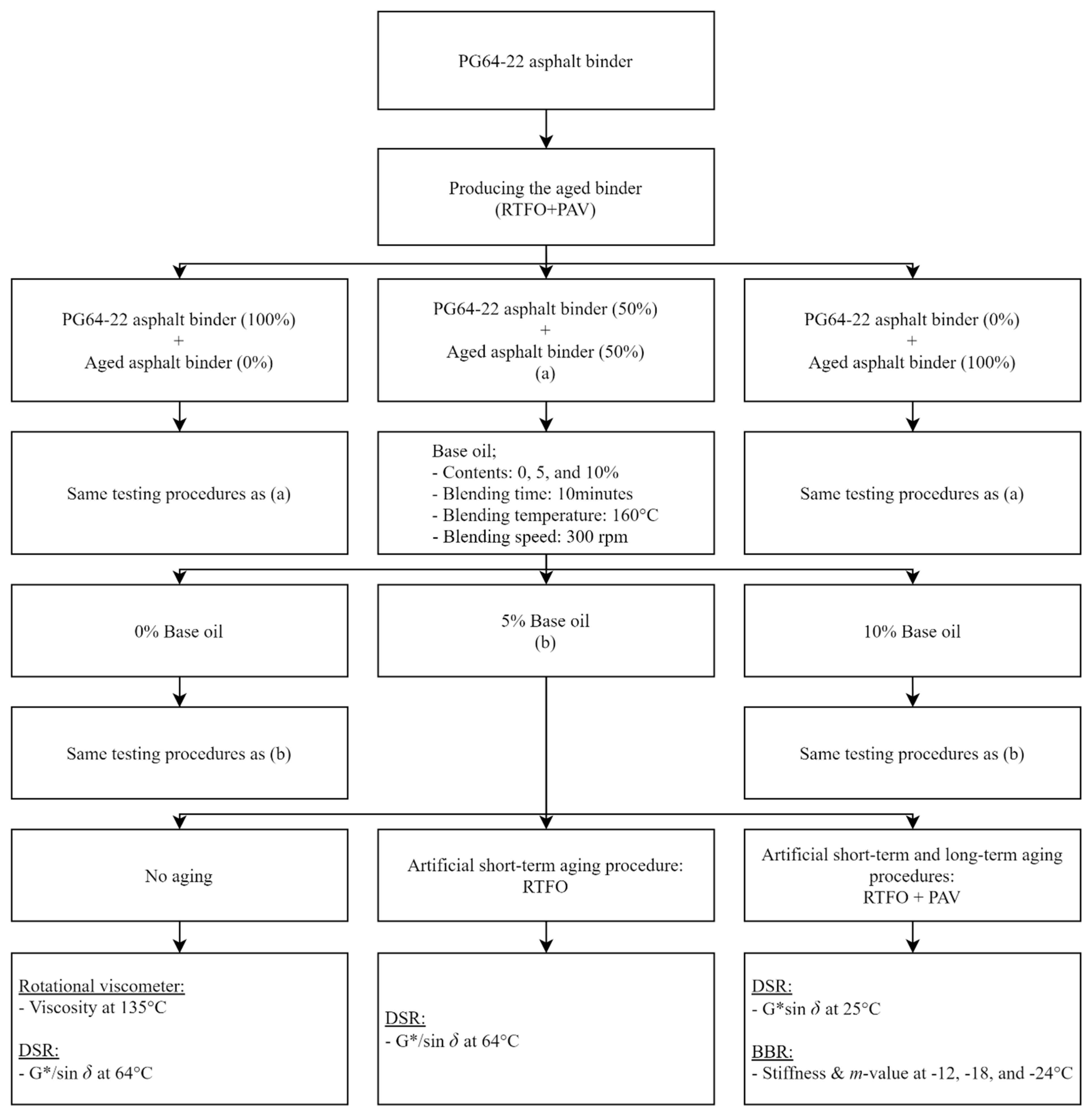

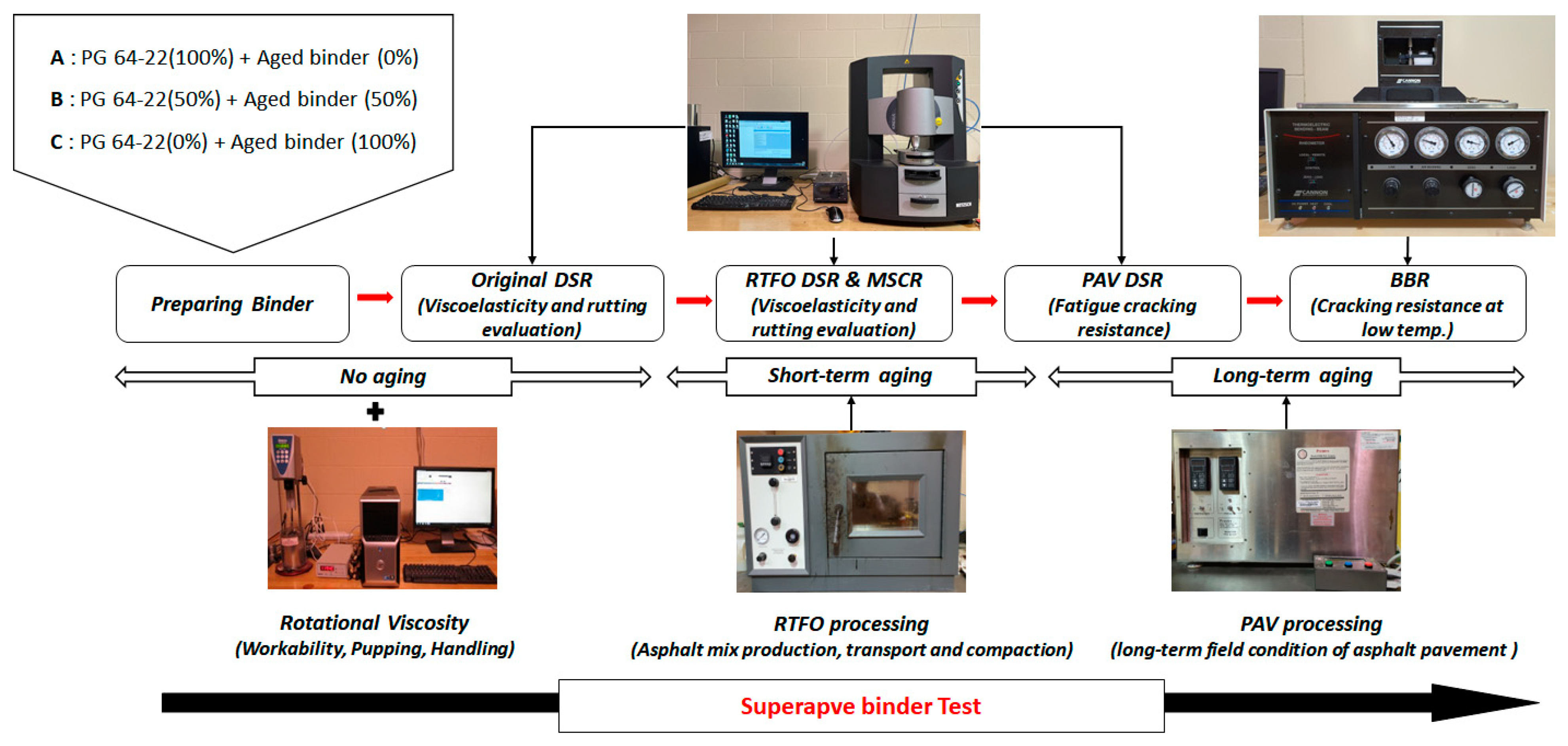
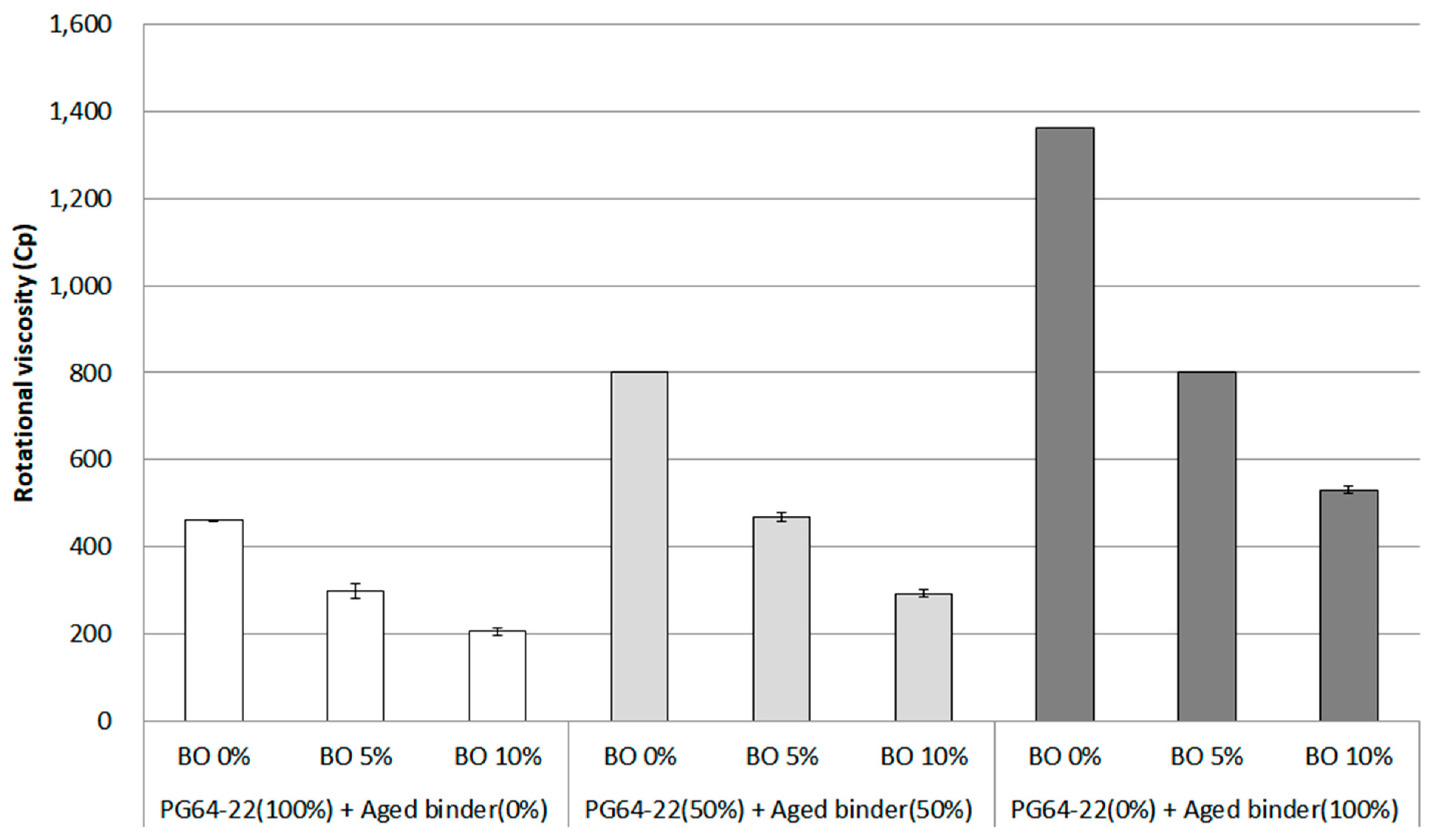

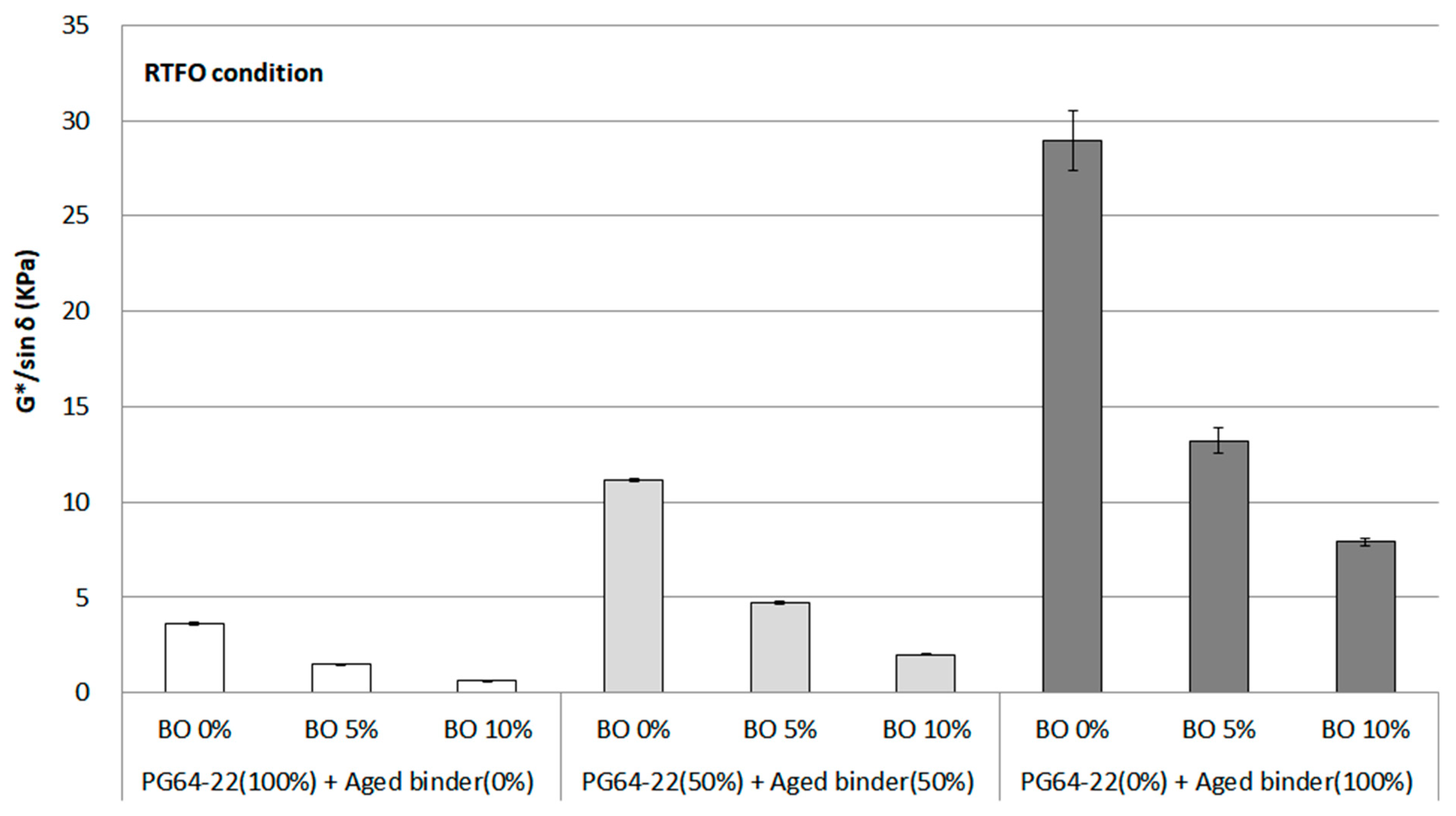

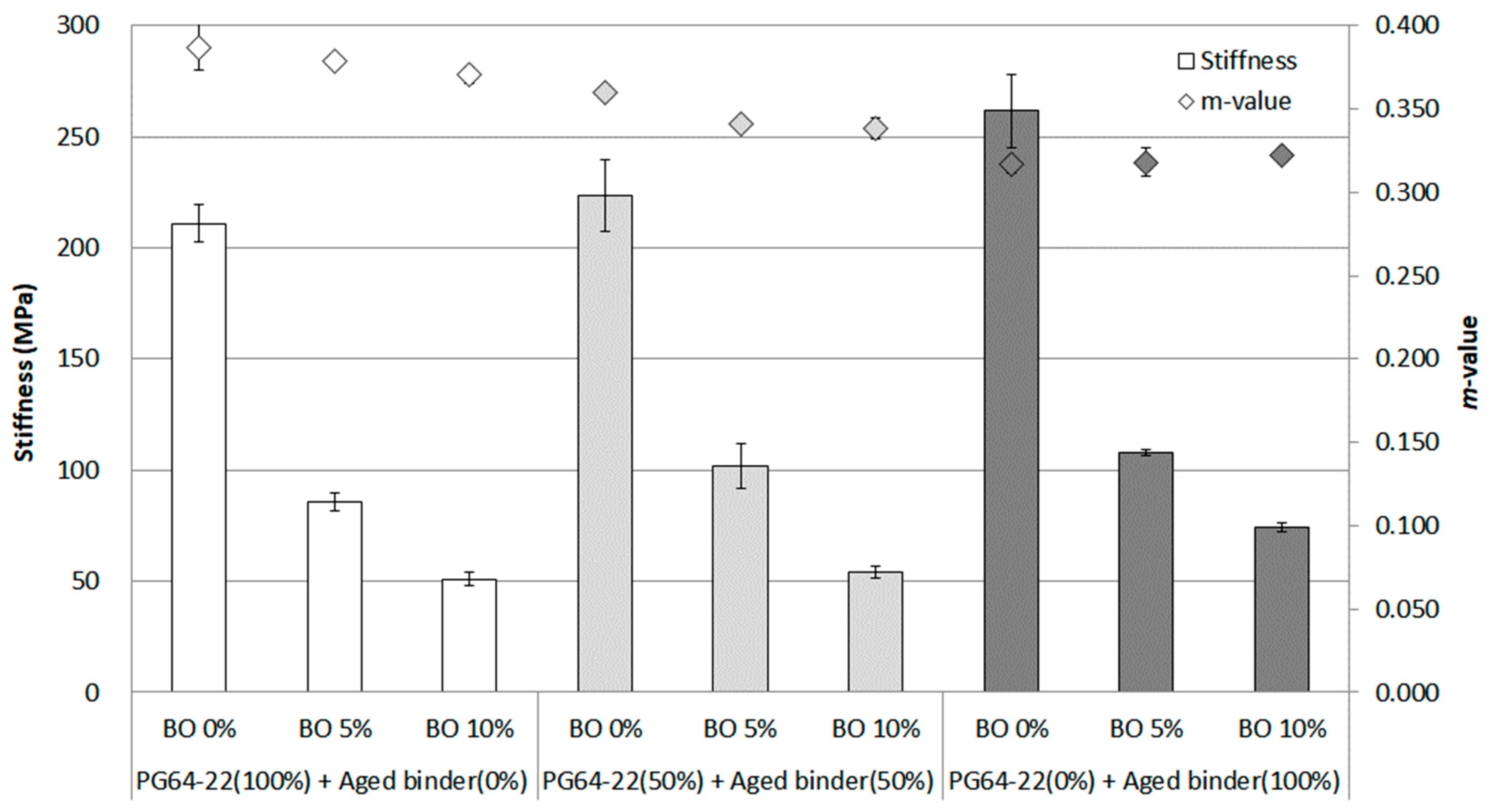

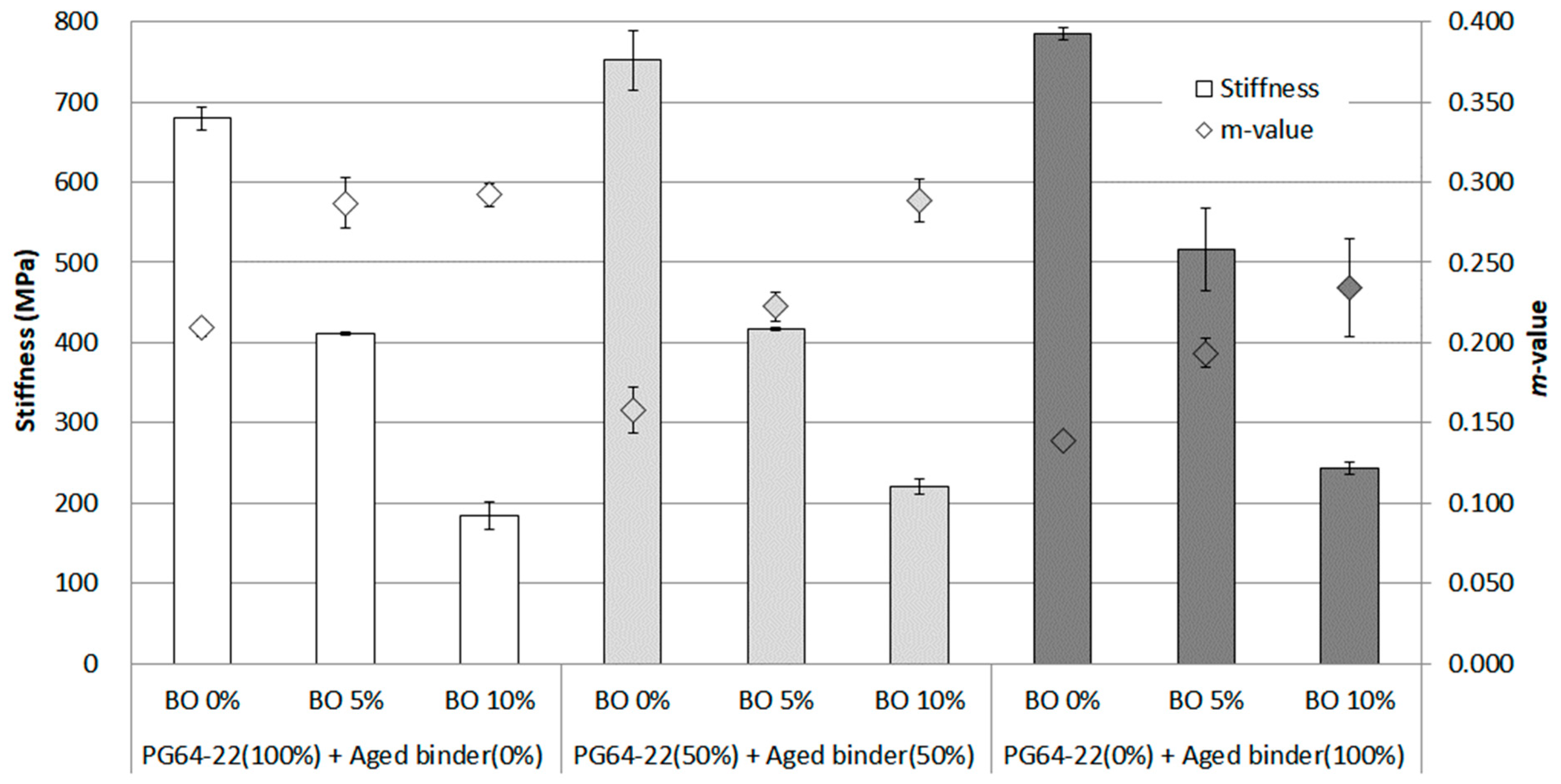
| Test Properties | Test Result | |
|---|---|---|
| Original binder | Viscosity @ 135 °C (cP) | 462 |
| G*/sin δ @ 64 °C (kPa) | 1.38 | |
| RTFO aged binder | G*/sin δ @ 64 °C (kPa) | 3.65 |
| RTFO + PAV aged binder | G*·sin δ @ 25 °C (kPa) | 3983 |
| Stiffness @ −12 °C (MPa) | 211 | |
| m-value @ −12 °C | 0.387 |
| Flash Point | Closed Cup: ≥220 °C (≥428 °F) |
|---|---|
| Vapor pressure | ≤0.01 kPa (≤0.075006 mm Hg) |
| Vapor density | ≥5 [Air = 1] |
| Relative density | 0.842 [Water = 1] |
| Partition coefficient: n-octanol/water | 3.9 to 6 |
| Auto-ignition temperature | 260 to 371 °C (500 to 699.8 °F) |
| Viscosity | Kinematic (40 °C (104 °F)): 0.36 cm2/s (36 cSt) |
| RV | Recycle % | 0 | 50 | 100 | ||||||
|---|---|---|---|---|---|---|---|---|---|---|
| Recycle % | BO % | 0 | 5 | 10 | 0 | 5 | 10 | 0 | 5 | 10 |
| 0 | 0 | - | S | S | S | N | S | S | S | S |
| 5 | - | S | S | S | N | S | S | S | ||
| 10 | - | S | S | S | S | S | S | |||
| 50 | 0 | - | S | S | S | N | S | |||
| 5 | - | S | S | S | S | |||||
| 10 | - | S | S | S | ||||||
| 100 | 0 | - | S | S | ||||||
| 5 | - | S | ||||||||
| 10 | - | |||||||||
| G*/sin δ (Orig.) | Recycle % | 0 | 50 | 100 | ||||||
|---|---|---|---|---|---|---|---|---|---|---|
| Recycle % | BO % | 0 | 5 | 10 | 0 | 5 | 10 | 0 | 5 | 10 |
| 0 | 0 | - | S | S | S | S | S | S | S | S |
| 5 | - | S | S | S | S | S | S | S | ||
| 10 | - | S | S | S | S | S | S | |||
| 50 | 0 | - | S | S | S | S | S | |||
| 5 | - | S | S | S | S | |||||
| 10 | - | S | S | S | ||||||
| 100 | 0 | - | S | S | ||||||
| 5 | - | S | ||||||||
| 10 | - | |||||||||
| G*/sin δ (RTFO) | Recycle % | 0 | 50 | 100 | ||||||
|---|---|---|---|---|---|---|---|---|---|---|
| Recycle % | BO % | 0 | 5 | 10 | 0 | 5 | 10 | 0 | 5 | 10 |
| 0 | 0 | - | S | S | S | S | S | S | S | S |
| 5 | - | N | S | S | N | S | S | S | ||
| 10 | - | S | S | S | S | S | S | |||
| 50 | 0 | - | S | S | S | S | S | |||
| 5 | - | S | S | S | S | |||||
| 10 | - | S | S | S | ||||||
| 100 | 0 | - | S | S | ||||||
| 5 | - | S | ||||||||
| 10 | - | |||||||||
| G*·sin δ PAV | Recycle % | 0 | 50 | 100 | ||||||
|---|---|---|---|---|---|---|---|---|---|---|
| Recycle % | BO % | 0 | 5 | 10 | 0 | 5 | 10 | 0 | 5 | 10 |
| 0 | 0 | - | S | S | S | S | S | S | N | S |
| 5 | - | S | S | S | N | S | S | S | ||
| 10 | - | S | S | S | S | S | S | |||
| 50 | 0 | - | S | S | S | S | S | |||
| 5 | - | S | S | S | N | |||||
| 10 | - | S | S | S | ||||||
| 100 | 0 | - | S | S | ||||||
| 5 | - | S | ||||||||
| 10 | - | |||||||||
| Stiffness at −12 °C | Recycle % | 0 | 50 | 100 | ||||||
|---|---|---|---|---|---|---|---|---|---|---|
| Recycle % | BO % | 0 | 5 | 10 | 0 | 5 | 10 | 0 | 5 | 10 |
| 0 | 0 | - | S | S | N | S | S | S | S | S |
| 5 | - | S | S | N | S | S | S | N | ||
| 10 | - | S | S | N | S | S | S | |||
| 50 | 0 | - | S | S | S | S | S | |||
| 5 | - | S | S | N | S | |||||
| 10 | - | S | S | N | ||||||
| 100 | 0 | - | S | S | ||||||
| 5 | - | S | ||||||||
| 10 | - | |||||||||
| m-value at −12 °C | Recycle % | 0 | 50 | 100 | ||||||
| Recycle % | BO % | 0 | 5 | 10 | 0 | 5 | 10 | 0 | 5 | 10 |
| 0 | 0 | - | N | S | S | S | S | S | S | S |
| 5 | - | N | S | S | S | S | S | S | ||
| 10 | - | N | S | S | S | S | S | |||
| 50 | 0 | - | S | S | S | S | S | |||
| 5 | - | N | S | S | S | |||||
| 10 | - | S | S | S | ||||||
| 100 | 0 | - | N | N | ||||||
| 5 | - | N | ||||||||
| 10 | - | |||||||||
| Stiffness at −18 °C | Recycle % | 0 | 50 | 100 | ||||||
|---|---|---|---|---|---|---|---|---|---|---|
| Recycle % | BO % | 0 | 5 | 10 | 0 | 5 | 10 | 0 | 5 | 10 |
| 0 | 0 | - | S | S | S | S | S | S | S | S |
| 5 | - | S | S | N | S | S | S | N | ||
| 10 | - | S | S | N | S | S | N | |||
| 50 | 0 | - | S | S | N | S | S | |||
| 5 | - | S | S | N | S | |||||
| 10 | - | S | S | S | ||||||
| 100 | 0 | - | S | S | ||||||
| 5 | - | S | ||||||||
| 10 | - | |||||||||
| m-value at −18 °C | Recycle % | 0 | 50 | 100 | ||||||
| Recycle % | BO % | 0 | 5 | 10 | 0 | 5 | 10 | 0 | 5 | 10 |
| 0 | 0 | - | S | S | S | N | N | S | S | S |
| 5 | - | N | S | S | S | S | S | S | ||
| 10 | - | S | S | S | S | S | S | |||
| 50 | 0 | - | S | S | N | N | N | |||
| 5 | - | N | S | S | S | |||||
| 10 | - | S | S | S | ||||||
| 100 | 0 | - | N | S | ||||||
| 5 | - | N | ||||||||
| 10 | - | |||||||||
| Stiffness at −24 °C | Recycle % | 0 | 50 | 100 | ||||||
|---|---|---|---|---|---|---|---|---|---|---|
| Recycle % | BO % | 0 | 5 | 10 | 0 | 5 | 10 | 0 | 5 | 10 |
| 0 | 0 | - | S | S | S | S | S | S | S | S |
| 5 | - | S | S | N | S | S | S | S | ||
| 10 | - | S | S | N | S | S | S | |||
| 50 | 0 | - | S | S | N | S | S | |||
| 5 | - | S | S | S | S | |||||
| 10 | - | S | S | S | ||||||
| 100 | 0 | - | S | S | ||||||
| 5 | - | S | ||||||||
| 10 | - | |||||||||
| m-value at −24 °C | Recycle % | 0 | 50 | 100 | ||||||
| Recycle % | BO % | 0 | 5 | 10 | 0 | 5 | 10 | 0 | 5 | 10 |
| 0 | 0 | - | S | S | S | N | S | S | N | N |
| 5 | - | N | S | S | N | S | S | S | ||
| 10 | - | S | S | N | S | S | S | |||
| 50 | 0 | - | S | S | N | S | S | |||
| 5 | - | S | S | N | N | |||||
| 10 | - | S | S | S | ||||||
| 100 | 0 | - | S | S | ||||||
| 5 | - | S | ||||||||
| 10 | - | |||||||||
Disclaimer/Publisher’s Note: The statements, opinions and data contained in all publications are solely those of the individual author(s) and contributor(s) and not of MDPI and/or the editor(s). MDPI and/or the editor(s) disclaim responsibility for any injury to people or property resulting from any ideas, methods, instructions or products referred to in the content. |
© 2023 by the authors. Licensee MDPI, Basel, Switzerland. This article is an open access article distributed under the terms and conditions of the Creative Commons Attribution (CC BY) license (https://creativecommons.org/licenses/by/4.0/).
Share and Cite
Yun, J.; Choi, H.J.; Na, I.-H.; Kim, H.H. Characterization of Base Oil Effects on Aged Asphalt Binders Considering Bicycle Road. Materials 2023, 16, 624. https://doi.org/10.3390/ma16020624
Yun J, Choi HJ, Na I-H, Kim HH. Characterization of Base Oil Effects on Aged Asphalt Binders Considering Bicycle Road. Materials. 2023; 16(2):624. https://doi.org/10.3390/ma16020624
Chicago/Turabian StyleYun, Jihyeon, Hyun Joon Choi, Il-Ho Na, and Hyun Hwan Kim. 2023. "Characterization of Base Oil Effects on Aged Asphalt Binders Considering Bicycle Road" Materials 16, no. 2: 624. https://doi.org/10.3390/ma16020624
APA StyleYun, J., Choi, H. J., Na, I.-H., & Kim, H. H. (2023). Characterization of Base Oil Effects on Aged Asphalt Binders Considering Bicycle Road. Materials, 16(2), 624. https://doi.org/10.3390/ma16020624







